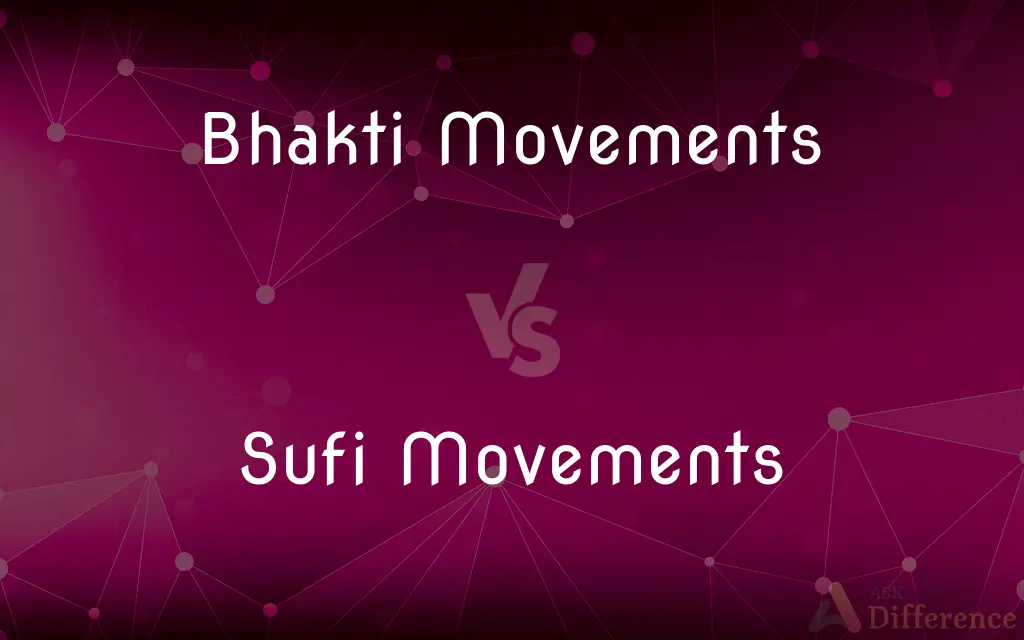Bhakti Movements vs. Sufi Movements — What's the Difference?
By Tayyaba Rehman — Published on January 3, 2024
Bhakti Movements focus on devotion to a personal god in Hinduism, emphasizing direct spiritual experience. Sufi Movements are Islamic mysticism emphasizing inward search for God and shunning materialism.

Difference Between Bhakti Movements and Sufi Movements
Table of Contents
ADVERTISEMENT
Key Differences
Bhakti Movements emerged in Hinduism as a spiritual reform movement focusing on loving devotion towards a personal god. It emphasized the importance of a direct, personal relationship with the divine, often bypassing traditional rituals and caste distinctions. Sufi Movements, in contrast, emerged within Islam as a mystical trend focusing on the inner, spiritual experience of God, often through meditation, chanting, and dancing, known as Sufi practices.
Bhakti Movements often propagated through poetry and songs written in local languages, making spirituality accessible to the common people. Saints like Mirabai, Kabir, and Tulsidas played a significant role. Sufi Movements also used poetry and music for spiritual expression, with notable figures like Rumi and Hafez, but their practices were deeply rooted in Islamic theology and law.
In Bhakti Movements, the focus was on breaking down the barriers of caste and religious exclusivity, promoting a message of love and equality. Conversely, Sufi Movements emphasized personal asceticism, inner purification, and the experience of divine love, often putting them at odds with orthodox Islamic practices.
Bhakti Movements contributed significantly to the regional languages and cultures of India, influencing arts, music, and literature. In contrast, Sufi Movements spread widely across the Islamic world, influencing cultural and artistic life in regions from South Asia to the Middle East, integrating local cultural elements with Islamic mysticism.
Both movements share a common emphasis on personal, emotional, and mystical union with the divine but differ in their religious contexts, practices, and cultural impacts. Bhakti Movements are an integral part of Hinduism's evolution, while Sufi Movements have significantly influenced the spiritual and cultural landscape of Islam.
ADVERTISEMENT
Comparison Chart
Religious Context
Hinduism
Islam
Focus
Devotion to a personal god, social reform
Inward search for God, spiritual experiences
Practices
Poetry, devotional songs, bypassing caste system
Meditation, chanting, dancing (Sufi practices)
Cultural Impact
Influenced regional Indian languages and arts
Influenced arts and culture across Islamic regions
Key Figures
Mirabai, Kabir, Tulsidas
Rumi, Hafez
Compare with Definitions
Bhakti Movements
Focuses on a personal relationship with God.
The Bhakti movement promoted direct spiritual experiences over rituals.
Sufi Movements
Often incorporates local cultural elements.
Sufi movements have adapted to local customs and traditions in different regions.
Bhakti Movements
Uses poetry and music for spiritual expression.
Bhakti saints composed poems and songs that are still popular in India.
Sufi Movements
Practices include meditation and Sufi dancing.
Sufi movements are known for their whirling dervishes and spiritual dances.
Bhakti Movements
Contributed to regional languages and culture.
Bhakti movements enriched Indian vernacular languages through their teachings.
Sufi Movements
Influenced cultural and artistic life in Islamic regions.
Sufi poetry and music have had a profound impact on Islamic culture.
Bhakti Movements
Spiritual reform in Hinduism emphasizing devotion.
Bhakti movements popularized worship through devotional songs.
Sufi Movements
Islamic mysticism focusing on inward spirituality.
Sufi movements emphasize a personal connection with God.
Bhakti Movements
Emphasizes equality and love in spirituality.
Bhakti movements played a key role in diminishing caste barriers in Hinduism.
Sufi Movements
Promotes asceticism and inner purification.
Sufis often follow a path of personal asceticism to attain spiritual enlightenment.
Common Curiosities
What is the goal of Sufi practices?
To achieve a deep, personal experience of God and spiritual enlightenment.
How did Bhakti Movements affect Indian society?
They promoted social reform, challenged caste systems, and enriched regional languages and arts.
What are Sufi Movements?
They are mystical trends within Islam focusing on inward spiritual experiences and divine love.
Are Sufi Movements part of mainstream Islam?
They are a mystical dimension within Islam but sometimes differ from orthodox practices.
How do Sufi and Bhakti teachings differ?
While both focus on a personal connection with the divine, their teachings and practices are rooted in different religious contexts - Hinduism and Islam, respectively.
What are Bhakti Movements?
They are reform movements within Hinduism emphasizing devotion and a personal connection with the divine.
Do Bhakti Movements reject traditional Hindu rituals?
They often place less emphasis on rituals, focusing more on personal devotion.
What languages were influenced by Bhakti Movements?
Many regional Indian languages, like Hindi, Marathi, and Bengali, were enriched by Bhakti literature.
How did Bhakti Movements spread their message?
Primarily through devotional songs, poetry, and teachings in local languages.
How have Bhakti Movements influenced modern Hinduism?
They have made devotional practices more accessible and emphasized personal spirituality.
What role does music play in Sufi Movements?
Music, particularly Sufi chanting and dancing, is a key element in spiritual practices and experiences.
Did Bhakti Movements contribute to social equality?
Yes, they played a significant role in promoting social equality and reducing caste discrimination.
Is meditation a part of Sufi practices?
Yes, meditation is a central practice in Sufism for spiritual connection.
Can anyone participate in Sufi or Bhakti practices?
Yes, both movements are inclusive and open to all individuals seeking spiritual experiences.
What is the significance of Sufi poetry and literature?
Sufi poetry and literature convey deep spiritual messages and have greatly influenced Islamic culture and arts.
Share Your Discovery

Previous Comparison
CRR vs. SLR
Next Comparison
Darwinism vs. Neo-DarwinismAuthor Spotlight
Written by
Tayyaba RehmanTayyaba Rehman is a distinguished writer, currently serving as a primary contributor to askdifference.com. As a researcher in semantics and etymology, Tayyaba's passion for the complexity of languages and their distinctions has found a perfect home on the platform. Tayyaba delves into the intricacies of language, distinguishing between commonly confused words and phrases, thereby providing clarity for readers worldwide.











































